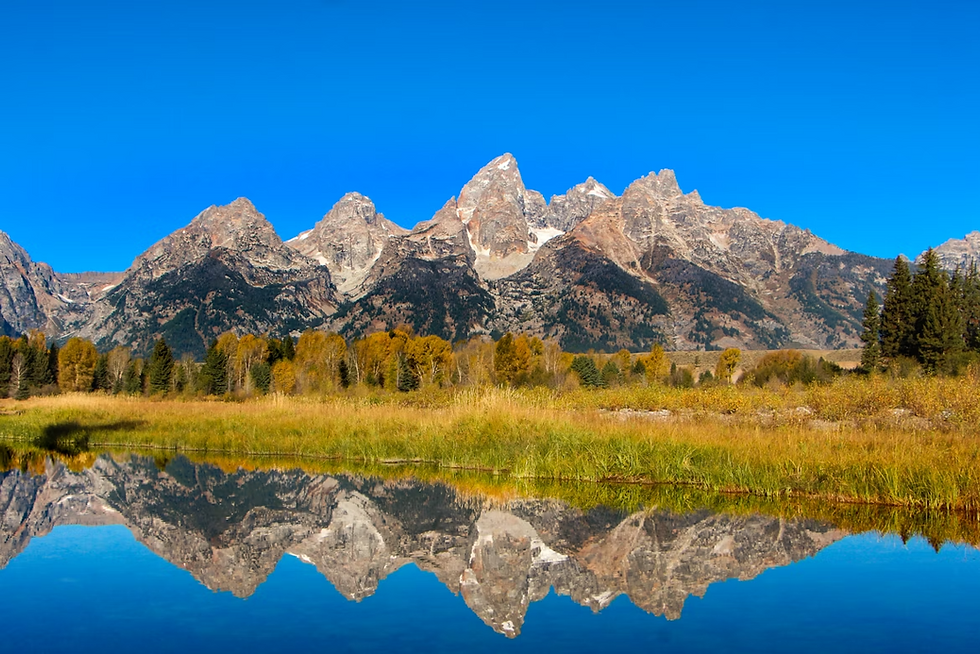Grand Teton National Park
- WD - Home

- Oct 3
- 3 min read
Updated: Oct 5
National Park Travel Guide

The Grand Teton National Park has a skyline you feel in your ribs. The range shoots straight up from sage flats with lakes strung at its feet like mirrors. Sunrise at Oxbow Bend, a paddle on String Lake, elk bugling in autumn, then alpenglow that stops conversation. The park is compact, photogenic, and endlessly hikeable.
The Tetons hit like a drumbeat, mountains erupting straight from the flats and echoing in your ribs.
How to Get There
Jackson is your launch pad, and Jackson Hole Airport sits right inside the park, which means your approach flight doubles as a scenic tour. The main Moose entrance off US-191 leads to Teton Park Road and the Craig Thomas Discovery and Visitor Center, where trail info, permits, and current conditions set you up for the week. No entrance reservations are required here, so arrivals are flexible; however, peak season lines at the gates are standard.
Nearest airport: JAC inside the park; additional options include IDA and BZN.
By car: US-191/26/89 along the Snake River to the Moose entrance.
Pairings: Easy loop with Yellowstone to the north.

Know Before You Go
No timed entry in Grand Teton. A standard park pass gets you in. Summer is busy, trailhead parking fills up early, and afternoon storms are a common occurrence. Bear spray is standard gear, and food storage rules are strict. Boat permits are required for anything that floats, including paddleboards.
Entrance: A fee is required; no vehicle reservations are accepted.
Permits: Backcountry camping and boating permits at Moose.
Wildlife: Bears and Moose are common; give space and carry spray.
Best Time to Visit
June brings wildflowers and full access. July and August deliver warm lake days and alpine trail conditions. September is magic with gold aspens, crisp mornings, and wildlife in motion. Winter is quiet and sparkling with groomed Nordic trails.
June–September: Peak hiking and paddling season.
Late September–early October: Fall color, elk rut, fewer crowds.
December–March: Nordic ski, sleigh rides on the refuge, big mountain views.

Best Things to Do
The park invites a rhythm. Mornings on the trail, afternoons by the lakes, golden-hour wildlife watching, then stargazing under a serious night sky.
Jenny Lake shuttle + Hidden Falls/Inspiration Point combo.
Scenic loop: Schwabacher Landing, Oxbow Bend, Mormon Row.
Paddle String or Leigh Lake: Glassy water and reflections.
Snake River float: Relaxed wildlife viewing from the water.
Craig Thomas Discovery and Visitor Center: Orientation and permits.
Best Hikes
Taggart Lake Loop (3.8 miles, easy-moderate): Perfect first-day hike with big Teton views.
Cascade Canyon to the Forks (9.4 miles, moderate): Glacier-cut canyon with peaks for company.
Amphitheater Lake (10 miles, strenuous): Classic high-alpine cirque.
Phelps Lake Overlook via Death Canyon TH (2.3 miles, easy-moderate): Quick wow.
Places to Stay
Decide if you want lakeside, town convenience, or a backcountry permit. Inside the park, it feels like a nature retreat, while Jackson offers walkable dinners and galleries.
In park: Jenny Lake Lodge, Jackson Lake Lodge, Colter Bay cabins and campsites.
Nearby: Lodges and hotels in Jackson such as the Four Seasons or Moody Mountain cabins.
Camping: Signal Mountain, Colter Bay, Gros Ventre. Reserve early.
Places to Eat
Fuel is readily available inside the park, offering the widest variety in town.
In park: Jenny Lake Lodge Dining Room, Signal Mountain Lodge restaurants.
Jackson favorites: Persephone Bakery for mornings, Dornan's for pizza with a view, Snake River Brewing for post-hike plates.


